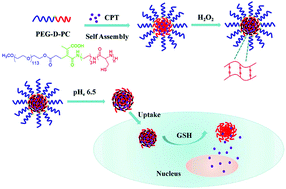当前位置:
X-MOL 学术
›
Polym. Chem.
›
论文详情
Our official English website, www.x-mol.net, welcomes your feedback! (Note: you will need to create a separate account there.)
Tumor pH and intracellular reduction responsive polypeptide nanomedicine with a sheddable PEG corona and a disulfide-cross-linked core†
Polymer Chemistry ( IF 4.6 ) Pub Date : 2018-06-05 00:00:00 , DOI: 10.1039/c8py00579f Yue Ding 1, 2, 3, 4, 5 , Chang Du 1, 2, 3, 4, 5 , Jiwen Qian 1, 2, 3, 4, 5 , Linzhu Zhou 1, 2, 3, 4, 5 , Yue Su 1, 2, 3, 4, 5 , Rong Zhang 5, 6, 7, 8, 9 , Chang-Ming Dong 1, 2, 3, 4, 5
Polymer Chemistry ( IF 4.6 ) Pub Date : 2018-06-05 00:00:00 , DOI: 10.1039/c8py00579f Yue Ding 1, 2, 3, 4, 5 , Chang Du 1, 2, 3, 4, 5 , Jiwen Qian 1, 2, 3, 4, 5 , Linzhu Zhou 1, 2, 3, 4, 5 , Yue Su 1, 2, 3, 4, 5 , Rong Zhang 5, 6, 7, 8, 9 , Chang-Ming Dong 1, 2, 3, 4, 5
Affiliation

|
To overcome the tumor and cellular barriers in cancer chemotherapy, the construction of biodegradable polymeric nanomedicine with pathological stimuli-responsivity is still challenging. In this work, a new class of polypeptide copolymer nanoparticles with a sheddable PEG corona and a dynamic disulfide bond cross-linked core was fabricated in aqueous solution, which can respond to tumor pH and intracellular reductive milieu. The polypeptide block copolymer (i.e., PEG-D-PC) composed of hydrophilic poly(ethylene glycol) (PEG) and thiol-pendant poly(L-cysteine) (PC) was synthesized via the primary amine terminated PEG dimethylmaleic anhydride derivative initiated ring-opening polymerization of α-amino acid N-carboxyanhydride and a sequential photocleavage reaction. The size and zeta potential change of the core-cross-linked (CCL) nanoparticles was monitored by on-line dynamic light scattering at pH 6.5, 10 mM DTT, and pH 6.5 + 10 mM DTT, respectively. In a similar manner, the anticancer drug camptothecin (CPT)-loaded CCL nanoparticles exhibited dual-stimuli-triggered drug release profiles. The CPT-loaded CCL79 nanoparticles facilitated the cellular internalization and CPT release inside the HeLa cells at pH 6.5, as confirmed by flow cytometry and fluorescence microscopy. The half maximal inhibitory concentration of CPT-loaded CCL79 nanoparticles at pH 6.5 was greatly lowered 31.8 fold to 0.61 μg CPT equiv. per mL compared to that at pH 7.4 + 0.1 mM BSO inhibitor, presenting dual stimuli-triggered cytotoxicity.
中文翻译:

具有可脱落的PEG电晕和二硫键交联核心的肿瘤pH和细胞内还原反应性多肽纳米药物†
为了克服癌症化学疗法中的肿瘤和细胞障碍,具有病理刺激响应性的可生物降解的聚合物纳米药物的构建仍然具有挑战性。在这项工作中,在水溶液中制备了一类具有可脱落的PEG电晕和动态二硫键交联核心的新型多肽共聚物纳米粒子,该纳米粒子可以响应肿瘤的pH和细胞内的还原环境。通过伯胺封端的PEG二甲基马来酸酐衍生物引发的环合成了由亲水性聚乙二醇(PEG)和硫醇侧链聚(L-半胱氨酸)(PC)组成的多肽嵌段共聚物(即PEG- D -PC)α-氨基酸N的开环聚合-羧基酐和顺序的光裂解反应。通过在线动态光散射分别在pH 6.5、10 mM DTT和pH 6.5 + 10 mM DTT上监测核心交联(CCL)纳米粒子的大小和zeta电位变化。以类似的方式,负载抗癌药喜树碱(CPT)的CCL纳米颗粒表现出双重刺激触发的药物释放曲线。流式细胞仪和荧光显微镜证实,CPT负载的CCL 79纳米颗粒促进了HeLa细胞在pH 6.5时的细胞内在化和CPT释放。载有CPT的CCL 79的最大抑制浓度的一半pH 6.5的纳米颗粒大大降低了31.8倍,降至0.61μgCPT当量。相比于pH 7.4 + 0.1 mM BSO抑制剂时的每毫升,呈现双重刺激触发的细胞毒性。
更新日期:2018-06-05
中文翻译:

具有可脱落的PEG电晕和二硫键交联核心的肿瘤pH和细胞内还原反应性多肽纳米药物†
为了克服癌症化学疗法中的肿瘤和细胞障碍,具有病理刺激响应性的可生物降解的聚合物纳米药物的构建仍然具有挑战性。在这项工作中,在水溶液中制备了一类具有可脱落的PEG电晕和动态二硫键交联核心的新型多肽共聚物纳米粒子,该纳米粒子可以响应肿瘤的pH和细胞内的还原环境。通过伯胺封端的PEG二甲基马来酸酐衍生物引发的环合成了由亲水性聚乙二醇(PEG)和硫醇侧链聚(L-半胱氨酸)(PC)组成的多肽嵌段共聚物(即PEG- D -PC)α-氨基酸N的开环聚合-羧基酐和顺序的光裂解反应。通过在线动态光散射分别在pH 6.5、10 mM DTT和pH 6.5 + 10 mM DTT上监测核心交联(CCL)纳米粒子的大小和zeta电位变化。以类似的方式,负载抗癌药喜树碱(CPT)的CCL纳米颗粒表现出双重刺激触发的药物释放曲线。流式细胞仪和荧光显微镜证实,CPT负载的CCL 79纳米颗粒促进了HeLa细胞在pH 6.5时的细胞内在化和CPT释放。载有CPT的CCL 79的最大抑制浓度的一半pH 6.5的纳米颗粒大大降低了31.8倍,降至0.61μgCPT当量。相比于pH 7.4 + 0.1 mM BSO抑制剂时的每毫升,呈现双重刺激触发的细胞毒性。


























 京公网安备 11010802027423号
京公网安备 11010802027423号